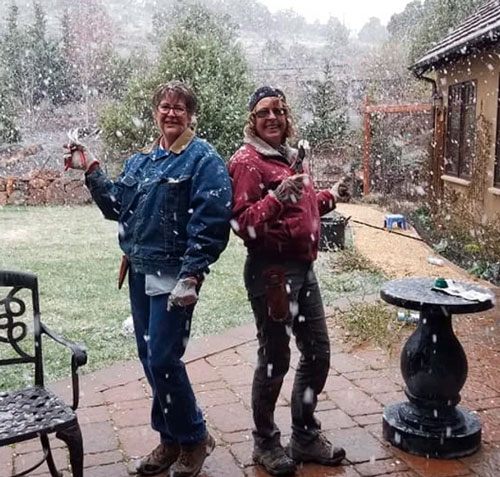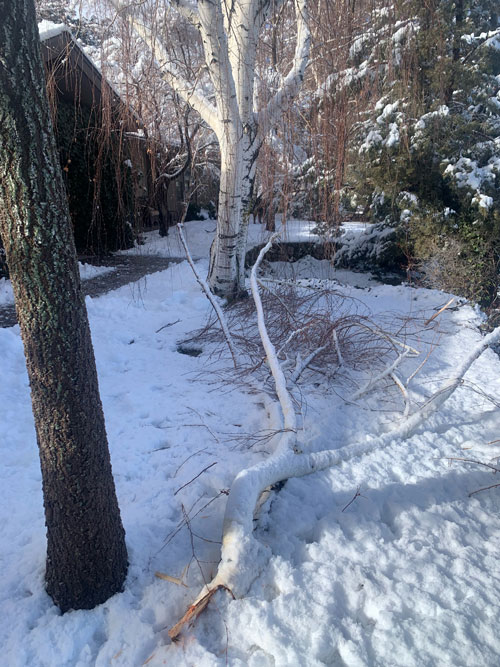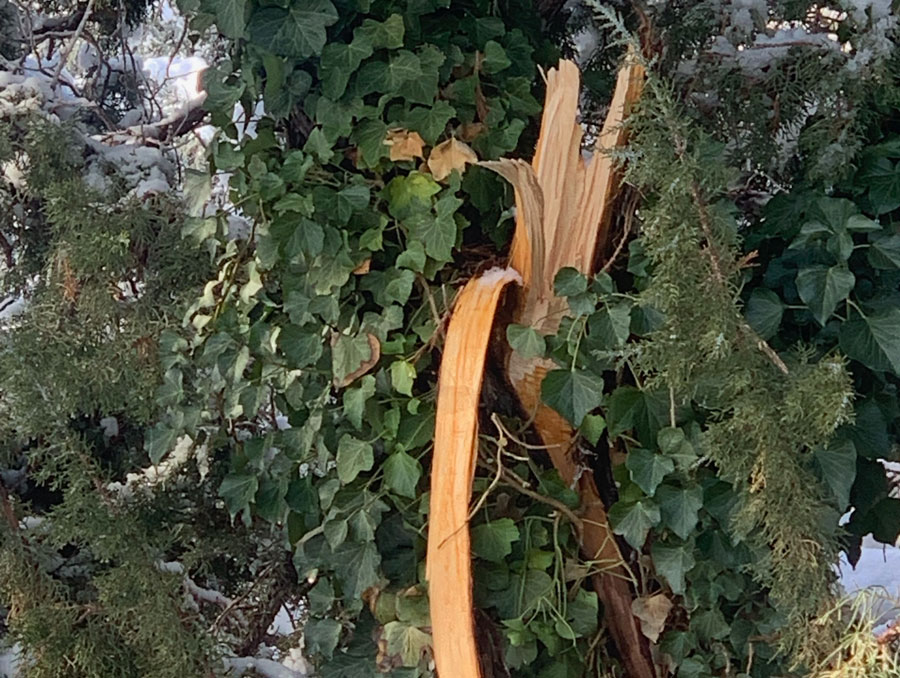
Trees are not immune to the extreme winter weather seen recently in the West. Heavy snowfall, wind and rain have caused treetops to bend to the ground, large limbs to snap, and even entire trees to fall to the ground. These trees are often beloved features of home landscaping and homeowners are asking what they can do to save weather-damaged trees.
University alumni and sisters Leslie Lyles and Holly Bromley are International Society of Arboriculture (ISA) certified arborists who specialize in plant problem diagnosis through their business, Stewardship Horticultural. They enjoy teaching both landscape professionals and homeowners how to properly care for their trees, and here they answer a few questions about how to respond after (and before) damage occurs.

Both alumni, Holly Bromley (left) received her B.S. in Biology and Leslie Lyles (right) earned her B.S. in Plant Science from the University. Lyles received her master’s in Environmental Horticulture from UC Davis. The sisters continue to teach classes in horticulture and tree care through the University of Nevada, Reno Extension.
Can trees survive after losing large limbs or branches?
Most trees can survive the loss of a small percentage of their branches, especially if good after-care is provided by a qualified ISA Certified Arborist. However, the greater the percentage of limb loss, the more it impairs the trees’ ability to thrive and thus survive long-term. Heavy damage causes physiological stress that increases the risk of disease, invasion by insects, decay organisms, and weakly attached new growth that can predispose the tree to even more branch failure in the future. Any tree that has suffered loss of large branches should be evaluated to determine if there is unseen damage such as cracks that have weakened the remaining branches or trunk. All broken limbs should be properly pruned to ensure proper closing of the wound.
If a healthy tree falls over, is there any way to save it?
There are generally two reasons that trees fall down: root failure or soil failure. Soil failure generally occurs with high winds after heavy precipitation that has saturated the soils. Root failure occurs when there is an intrinsic fault in the root system such as kinked or girdling roots, root damage from construction or poor-quality nursery stock that led to the roots never establishing properly. Seemingly “healthy” trees can, in fact, have deficient root systems that make them poor candidates for saving.
Successfully righting and re-establishing a fallen tree is difficult, especially with larger trees, and it carries the risk of the tree growing even larger only to fall again in the future. Determining if a tree can (or more importantly should) be saved depends mostly on its size, health, and quality of the remaining root system. Only an experienced ISA Certified Arborist can make an accurate assessment as to whether a tree can be successfully saved after such a catastrophic event, but usually, the answer will be no.
What is the best way to help a tree recover after losing a large limb?

The tree needs to be evaluated by an ISA Certified Arborist to determine the extent of damage and to properly prune the branch stub with a clean cut to help the tree effectively compartmentalize the wound (this, in layman’s terms, equates to proper healing and sealing of the wound.) The higher the percentage of canopy loss, the more likely the tree is to respond with rapid, weak overgrowth of new limbs that can fail even more easily in future weather events.
The leaf surface area of a tree helps feed the tree through photosynthesis. Large limb failure causes a reduction in leaf surface area, often resulting in proportionate root loss. It is for this reason that paying extra attention to root health is important. Even if the limb loss is not too extensive, the tree can experience physiological stress; good irrigation practices mitigate this stress. Despite the heavy winter precipitation that we’ve experienced this year, our long, hot, dry summers are hard on trees that don’t get sufficient water. Drought only adds further stress to an already stressed tree, thus reducing its vigor and chances of long-term survival. If you have concerns about your landscape, having a Landscape Health Evaluation performed by a consulting arborist can help address your concerns and give you a plan for correcting any problems.
What preventative measures can be taken to protect trees from future damage, particularly from heavy snowfall?
We have observed that a great percentage of limb failure was on weakly attached branches that had bark inclusions, a defect that predisposes branches to failure. This defect can be identified by a qualified arborist and mitigated with proper pruning. Good pruning practices also reduce the risk of failure by removing excess weight on branch tips and overcrowding of branches. The best time to start structural pruning is in the first few years after planting. Hiring a Certified Arborist who specializes in small tree pruning is one of your best defenses against future failures.
Exceedingly wet, heavy snow is a weather event that we have little control over. When we have this type of snowfall event, there are steps you can take to help protect your trees. With smaller trees, one can take a broom and try to shake or knock the snow off (don’t use a hard metal implement such as a hoe or rake as the metal will damage the branches.) With all trees, keeping them healthy and properly pruned is the best prevention we can offer.
Are there trees that are prone (or less prone) to limb breakage?
Any tree that has a structural defect can easily suffer damage from heavy snow regardless of species. However, there are some species that seem to have a greater risk of branch loss. The branches of densely branched trees such as ornamental plum, umbrella catalpa or weeping mulberry can catch a disproportionate amount of snow for their size and thus tend to succumb to the weight of heavy snow easier than lightly branched trees. Additionally, weak-wooded trees such as poplar and willow may be more prone to branch loss while hard-woods such as oak and maple may survive better. (Anecdotally, Holly’s neighbor’s poplar fared well as the heavy snow-weighted branches seemed to bend resiliently while her silver maple suffered heavy branch loss. Often, we are simply at the whims of nature.)
Any other tips for tree care during the winter months?
Winter is a very active time for new root growth in trees. Even while the tops of deciduous trees stand leafless and dormant, the root system is expanding and getting ready for the upcoming growing season. Many years we can go weeks without significant precipitation during winter months. During these years it is important to periodically water our trees to keep the soil moist and prevent winter root loss.
This year we are experiencing quite the opposite and trees can die of drowning if the soils remain flooded for too many days. If the ground around your trees remains flooded for too long, the lack of oxygen in saturated soil will eventually kill the roots, and thus the tree. Whenever possible, pumping away or trenching to drain the water from the root zone should be done as soon as possible to prevent the loss of trees that survived the harsh storm, only to die from flooding.












